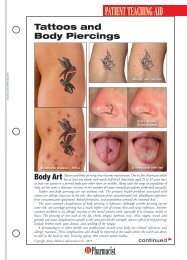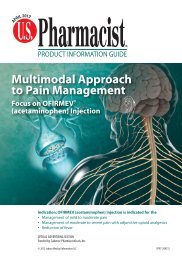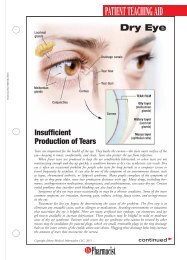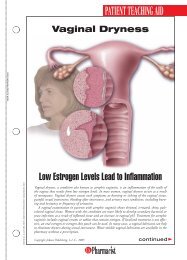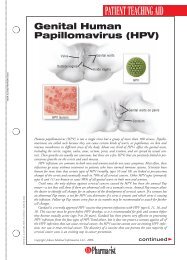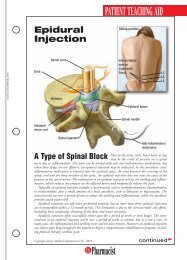Vaginal Yeast Infection - US Pharmacist
Vaginal Yeast Infection - US Pharmacist
Vaginal Yeast Infection - US Pharmacist
Create successful ePaper yourself
Turn your PDF publications into a flip-book with our unique Google optimized e-Paper software.
PATIENT TEACHING AID<br />
<strong>Vaginal</strong> <strong>Yeast</strong><br />
<strong>Infection</strong><br />
TEAR ALONG PERFORATION<br />
An overgrowth of Candida albicans causes<br />
a yeast infection on the walls of the vagina<br />
MEDICAL ILL<strong>US</strong>TRATION: © KRISTEN WEINANDT MARZEJON 2007<br />
Inflamed <strong>Vaginal</strong> Tissue<br />
Vaginitis is an inflammation of the vaginal tissue that can be accompanied by intense itching, pain,<br />
and discharge. One of the most common causes of vaginitis is an overgrowth of Candida albicans,<br />
a fungus often found in the vagina in small quantities. The acidic environment of the vagina keeps<br />
the growth of Candida albicans under control by allowing protective bacteria to flourish. If this<br />
environment changes, the balance between fungus and bacterial growth can lead to fungal overgrowth<br />
and inflammation.<br />
More than 75% of all women suffer from a vaginal yeast infection at some time during their<br />
lives, and it is common for these infections to reoccur even when treated properly. Antibiotic therapy,<br />
hormonal changes, and chronic conditions that weaken the immune system are typical causes<br />
of vaginal yeast infections. Symptoms range from mild vaginal itching or burning to severe itching,<br />
swelling, and burning, accompanied by a white, watery or thick discharge. When the symptoms of<br />
vaginitis occur for the first time, a woman should be evaluated by her doctor to determine the cause.<br />
Most uncomplicated vaginal yeast infections can be treated with nonprescription antifungal vaginal<br />
creams or suppositories. If the infection does not respond to nonprescription medications, an oral<br />
antifungal can be prescribed by the doctor. Simple changes in daily routines can help prevent future<br />
vaginal yeast infections.<br />
Copyright Jobson Medical Information LLC, 2007<br />
continued
PATIENT TEACHING AID<br />
Uncomfortable,<br />
Often Recurrent<br />
Condition in Women<br />
A vaginal yeast infection, also known as vaginal candidiasis, is an<br />
inflammation of the vaginal tissue usually caused by an overgrowth<br />
of Candida albicans, a fungus commonly found in the vagina. This<br />
overgrowth results from a change in the acidic environment in the<br />
vagina, allowing the Candida to grow unchecked by protective bacteria.<br />
The vaginal environment can be changed by several factors, all of<br />
which increase the risk of infection. An infection will often arise after<br />
treatment with oral antibiotics, which kill the protective bacteria and<br />
allow the fungus to survive and flourish. Changes in hormone levels,<br />
which can occur during pregnancy, menstrual periods, or while taking<br />
birth control pills, can also alter the vaginal environment and favor fungal<br />
overgrowth. Diseases that result in suppression of the immune system,<br />
such as cancer, HIV, or AIDS, can also be risk factors.<br />
A vaginal yeast infection<br />
results from fungal overgrowth,<br />
which is caused by<br />
a change in the vaginal<br />
environment. Contributing<br />
factors include antibiotics,<br />
hormonal changes, and a<br />
weakened immune system.<br />
Signs and Symptoms: The classic symptoms of a vaginal yeast infection include burning and itching<br />
of the vaginal tissue and vulvar area (tissue outside the vagina). Some women notice a vaginal<br />
discharge often described as a thin, white, or watery or a thicker discharge resembling cottage cheese.<br />
A woman may also experience redness and swelling of the vulvar tissue, painful urination, or pain<br />
during intercourse. Not all these symptoms are present in every woman with a vaginal yeast infection.<br />
In addition, many symptoms are similar to those of vaginal infections caused by bacteria or<br />
trichomonas. Since the symptoms of vaginitis can be similar regardless of the cause, it is important<br />
that a doctor’s examination and laboratory testing of the discharge are used to confirm the<br />
diagnosis of Candida when the initial infection occurs so the correct therapy can begin. Once the<br />
patient is able to recognize the symptoms of a typical yeast infection, future infections can be treated<br />
using nonprescription vaginal antifungal medication, such as clotrimazole or miconazole.<br />
Although vaginal candidiasis is not considered to be a sexually transmitted disease, it can occasionally<br />
be transmitted to a partner through intercourse. If symptoms develop in a sexual partner,<br />
a doctor should be contacted to decide on the most effective treatment.<br />
Chronic vaginal yeast infections could be a sign of immune system depression, such as that which<br />
occurs in diabetes or HIV/AIDS. A physician should be contacted if a single course of nonprescription<br />
antifungal therapy is not effective and the vaginal yeast infection reoccurs.<br />
OTC and Prescription Medications: Several approved vaginal antifungal products are available<br />
without a prescription either as a cream or suppository inserted into the vagina for a specified<br />
number of days. Some products provide an additional amount of cream that can be used on the<br />
vulvar area to help relieve itching. If these products are not effective in the time specified on the<br />
instructions, a doctor should be contacted for follow-up. An oral antifungal drug (e.g., fluconazole)<br />
may be prescribed when nonprescription medications fail. The symptoms may not be caused<br />
by Candida albicans, in which case no antifungal medication will successfully treat the vaginitis.<br />
Preventive Measures: There are several recommendations for the prevention of recurring vaginal<br />
yeast infections that may be effective. Some doctors recommend adding yogurt and/or cranberry<br />
juice to the diet to help restore a normal vaginal environment that will not favor the overgrowth<br />
of fungus. To prevent excess moisture in the genital area that can provide an ideal environment for<br />
fungal growth, cotton crotch underwear and loose-fitting clothes are preferred. Wet bathing suits<br />
and workout clothing should be removed as soon as possible and washed prior to next use. Avoiding<br />
the use of feminine hygiene products, vaginal deodorants, and douches is recommended, since<br />
they can cause recurrent irritation of the vaginal tissue.




